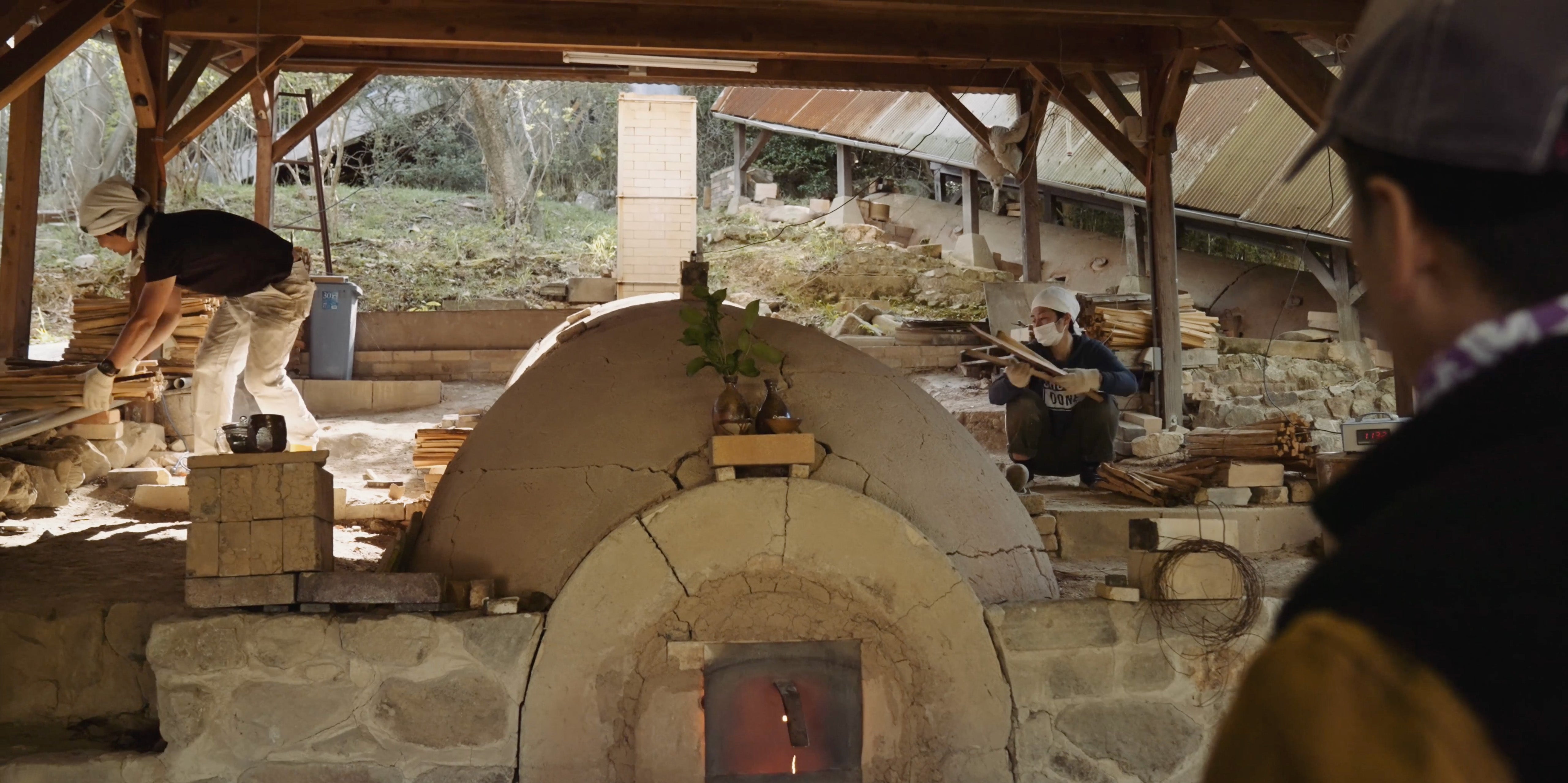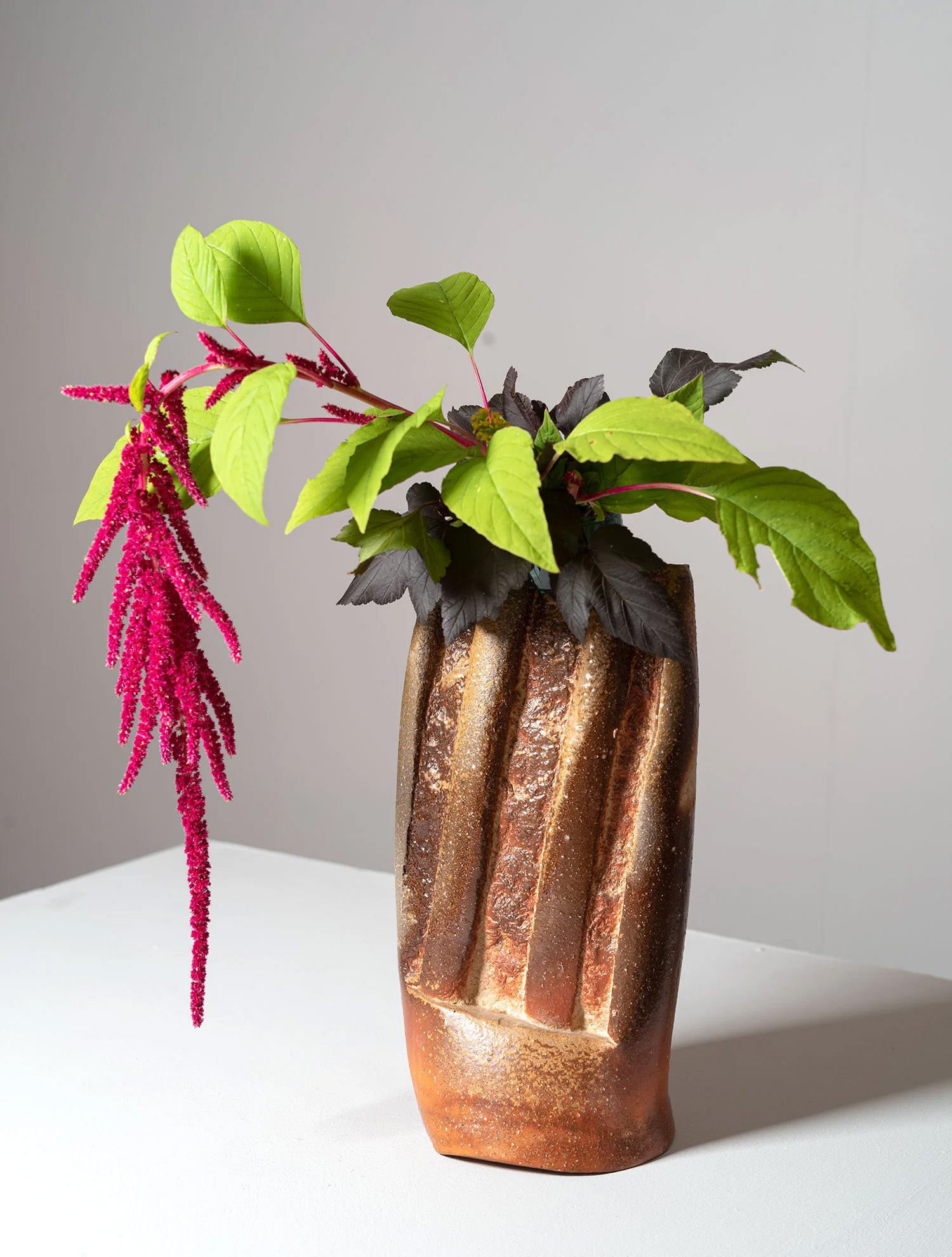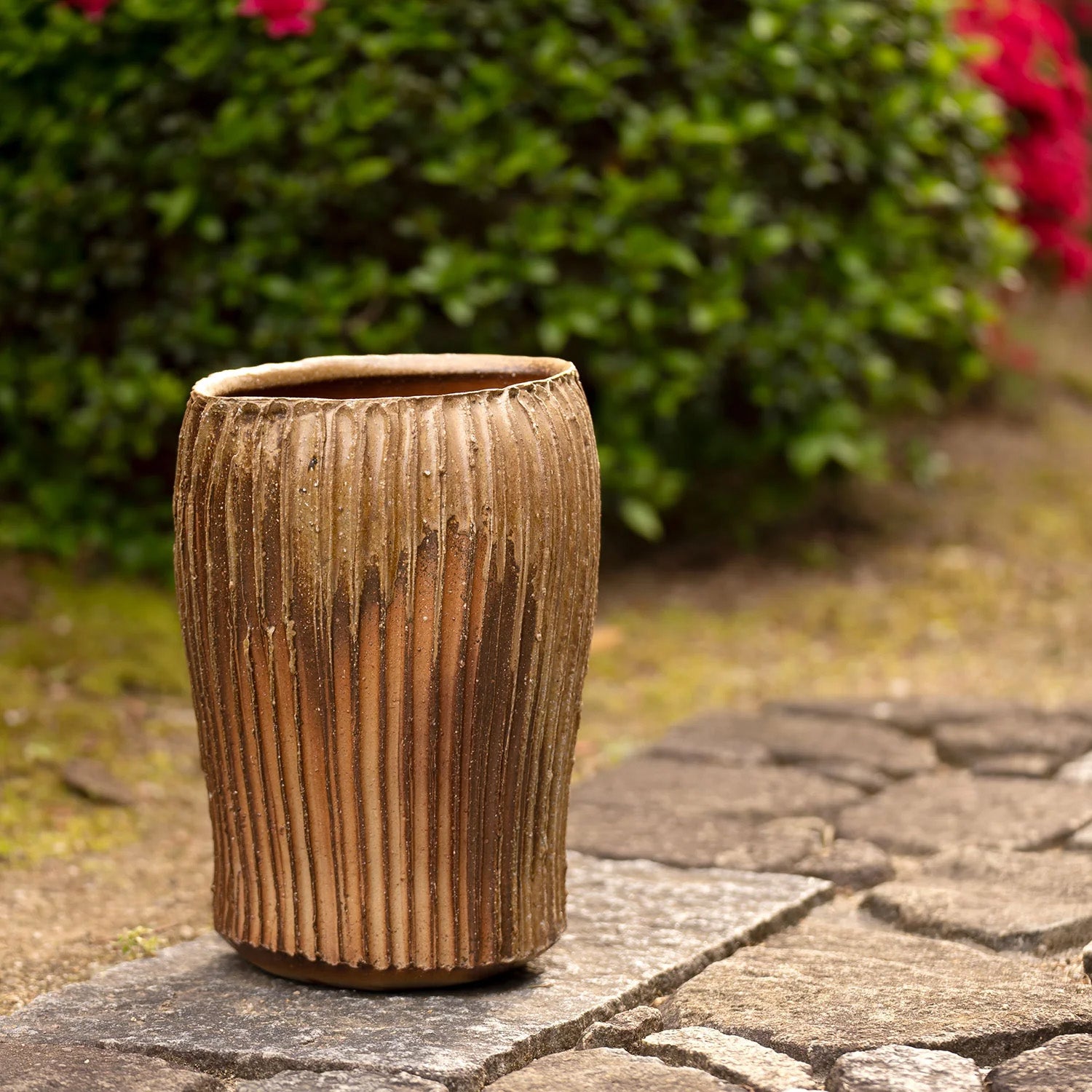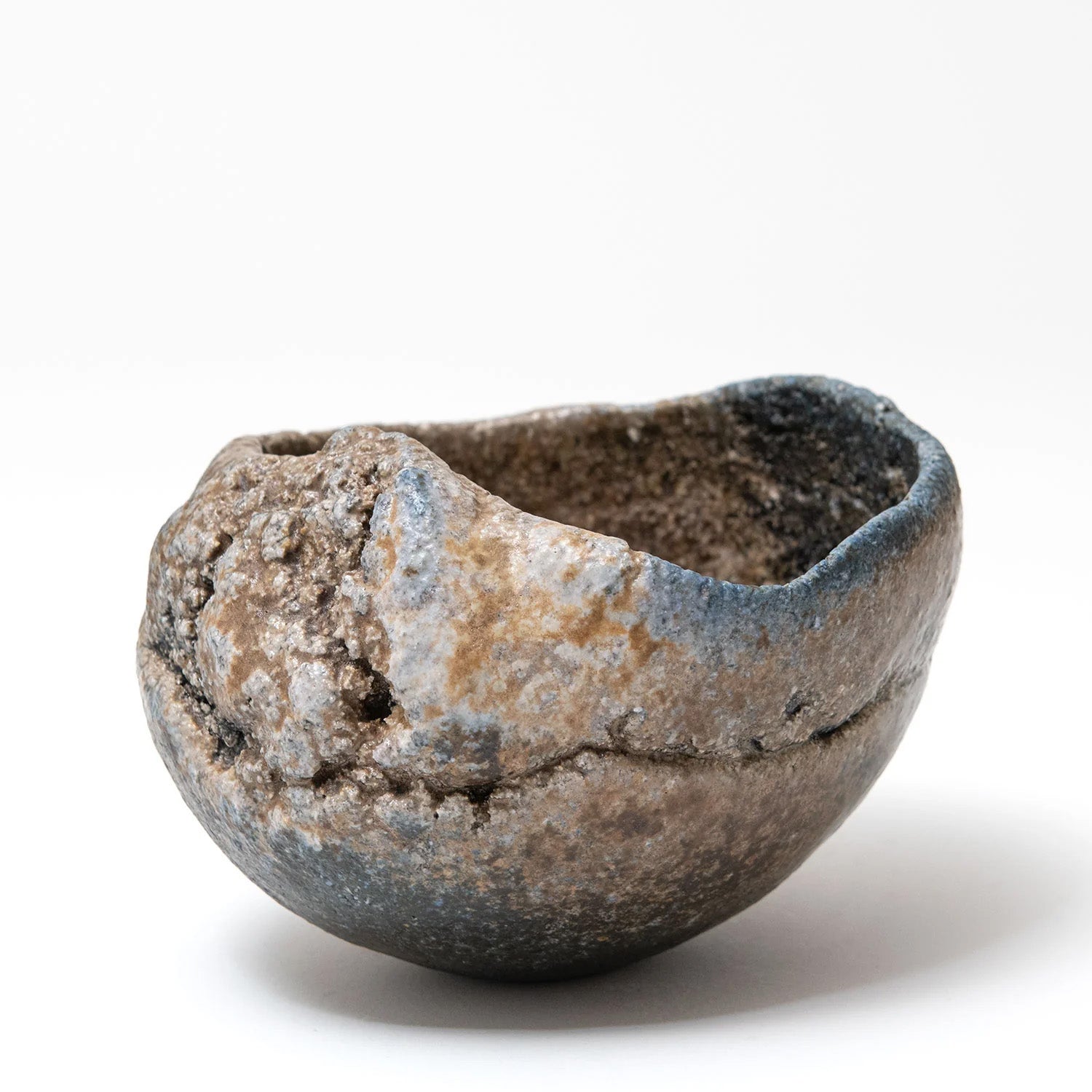Recently in conversation with Isezaki Kôichiro (b. 1974) discussing his first solo exhibition at Goldmark Gallery, he alluded to the experience of working with clay as being ‘one of presence with the clay and of being present with and through the process.’ Kôichiro feels clay is a living entity (ikimono) and he works with its lifeforce. Kôichiro mentioned that he is drawn to the materiality of clay and his approach to his work is basically intuitive. The term presence took me a bit by surprise but then I realised that it was in fact the key to understanding Kôichiro’s practise. His presence with the clay as he initially prepares, examines and then starts to form it, in turn informs the finished work. His recent exploration of form in his compelling series titled Yô (Gestation), for example, probes the clay’s softness along with the movement inherent in clay. The Yô series releases unusual forms within the clay as channelled through Kôichiro. The result is impactful work which Kôichiro classifies not as sculpture but rather as a vessel (utsuwa). This point is important, as vessels imply functionality, a key aspect of Japan’s traditional craft (kôgei) expression.

Koichiro Isezaki working in his Bizen studio
Izesaki Kôichiro was born into a fabled ceramic lineage at the heart of one of in Japan’s traditional craft industries. He is the eldest son of the Living National Treasure (officially ‘Preserver of an Important Intangible Cultural Property’) Isezaki Jun (b. 1936) and grandson to the famous sculptural form potter (saikumono) Isezaki Yozan (1902-1961), who was himself a designated Okayama Prefecture Intangible Cultural Property. Kôichiro continues the tradition of Bizen ceramics. Bizen ware itself has an 800-year plus lineage of production coming into particular prominence during the Momoyama period (1573-1615) with interest from tea aficionados, in the Edo period (1615-1868) with new forms of tablewares such as tokkuri (sake flasks) and then again in the Meiji era particularly with sculptural forms. In the first half of the 20th century, Bizen ceramics garnered attention once more with the Mingei Folk art movement and in the immediate post WWII era with the revival of historical Momoyama period styles. More recently Bizen potters have gained prominence through innovative employment of traditional vocabulary of form as pioneered with Isezaki Jun, Kôichiro’s father. Bizen has a tactile texture and instantly recognisable which is both its charm and its challenge.

Koichiro Isezaki and colleagues and his wood firing kiln
Bizen clay is harvested in the local region around Inbe, Okayama Prefecture from multiple sources - ranging from rice patty fields to the surrounding hillsides depending on the style of ceramic to be created. Each clay source contains different properties that can be used alone or combined together for the desired effect. The raw clay is set aside to mature before it is processed. Kôichiro confirmed to me that he is present for all stages of the production process from start to finish. He has gathered the clay himself and understands the locations and properties of each source, including more than enough clay put aside in the Isezaki compound for even his grandchildren to use.
Process matters especially with Bizen ceramics. There are many ways to form Bizen ware and Kôichiro employs a wide range from hand forming, tataki (paddling), slab construction, use of a pugmill, slicing and wheel throwing. Athough there are some glazed Bizen wares made in the later Edo period, Bizen ceramics as a whole are not intentionally glazed. Rather, the surface decoration and textures are played with and enhanced with slip, straw, charcoal, ash-glaze strategic placement, saggars (containers in the kiln) and natural ash glaze.
Historically Bizen ware was fired in an anagama or single chamber tunnel kiln dug into the side of a mountain. In the Momoyama period when orders increased ôgama or large chambered kilns and even noborigama, climbing kilns with multiple chambers, were employed. Kôichiro’s grandfather rediscovered the historic anagama kiln form that both his father and he himself now use. History is important to the region and informs the Isezaki family’s overall practise. I remember when Isezaki Jun and Kôichiro took my students and me a to a Momoyama era ôgama kiln site near their compound and graphically explained kiln practices then and now. The palpable similarities in process were overwhelming.

Koichiro Isezaki in his studio making a Yō
The kiln firing is perhaps the most essential component in the process. Kôichiro uses his own anagama kiln and fires it twice to three times a year feeding it with copious amounts of red pine. The firing which can last up to 8 days is the culmination of the creation process. Kôichiro is present for the entire firing cycle. Placement in the kiln can make all the difference to the surface effects of the works. He personally replaces or reworks the kiln every 20 years. When it is newly built as is local practise, he asks a local Shinto priest to bless the kiln. For the biannual firings he makes only a simple offering of sake and a branch of sakaki (Cleyera japonica) over the firing box of the kiln to ask only for an uneventful firing as he does not want to overly influence the final part of the process.
Kôichiro mentioned that he is drawn both to clay and to flame. He enjoys both the form and surface textures. His relationship with the forms is one of inside and out; it is the outer form he focuses on by working the inner part of the vessel. He told me that clay with its inherent life force (seimeikan) widens and for him design does not come first. What is always first is his impression of the clay through his presence with it.
Movies, he mentioned, are a particular source of inspiration. Anything from the Cohen brothers to old French films are fodder for him. He is drawn to Ozu Yasujirô’s (1903-1963) films with their unique camera angles. He spoke specifically of the family scenes at the round dining table and the impossibly low angles, Ozu’s hallmark, that shift the viewer’s perceptions of family relationships and environment often through the use of intervals- relationships or space that is expressed in Japanese as ma (間). With movies he sees the Director as assembling the materials, actors and the script, and forming it much like working with clay. What does the Director wish to say through the film? How does he employ the materials to that specific end? I asked about music and if he listens while he is working. Kôichiro explained that his tastes run from classical to Bjork and while he listened to music in his workshop at the beginning of his practise, now he does not play music and listens only to the clay. He is fully present with his materials and the process. The clay makes sounds that reveal information is one is listening. The kiln firing also speaks, making sounds that alert him about the process and what is needed to facilitate it. Kôichiro is alone when he is creating although his father often wanders in wordlessly and observes the work and then departs.
I asked Kôichiro about his relationship with his father. He mentioned that initially he had no desire to become a potter and his father never pushed him one way or another. In passing he said that the fact that his father was not strict at all was in fact hard and even frightening. He went to art college, Tokyo Zôkei University, and it was only after graduation that he realised he already possessed at home all the materials he needed to create what was within him already. He went back home and apprenticed initially with his father and then with his father’s former apprentice Jeff Shapiro in upstate NY for two years. He had known Jeff since he was a child at his father’s workshop. During his apprenticeship with Jeff Kôichiro spoke only English and this has the double effect of making him fluent in the language and able to see the ceramic practise in different perspective . He returned to his father’s workshop and spent another four years there gradually starting to make his own forms. He is now completely independent artist but integrated into the overall Isezaki compound.

National Living Treasure Jun Isezaki with Koichiro Isezaki, Bizen, Japan
Kôichiro signs his works with a hiragana (phonetic) ko (こ) on the base in an unobtrusive place and wraps his finished ceramics in a reddish brown cotton cloth that has a seal on one point to help with the wrapping process -- a conceptual sealing of the work -- before it is placed in its purpose made box. I asked him about his choice of colour as many artists use a turmeric-coloured yellow cloth. His response was in line with his practice of presence with his work, namely that his ceramics responded best with the reddish-brown colour.
Clay and its makers have a special relationship. For Kôichiro what resonates are traditions and strategically breaking free from those traditions; frames of reference (kata) and freedom within those frames. Ceramics, he told me, need to be healthy in and of themselves and enjoyed. There must be a reason for making them, and people need to respond to the works. Translation or repetition is not healthy for the form or the practitioner. He is not trying to make interesting shapes, rather he is attempting to be present for the process, and this is reflected in the final form. For Kôichiro the highest compliment is not specific praise for an individual work but just overall positive reaction to the medium.
Nicole Coolidge Rousmaniere
Research Director, Sainsbury Institute for the Study of Japanese Arts and Cultures, University of East Anglia
















